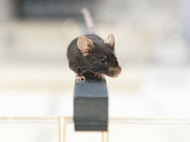
The mouse as a model organism
Where there are people, there are mice. This pretty well summarizes the millennia-old relationship between man and mouse. Few species have benefited from humans as much as the house mouse, Mus musculus. Native to the Indian subcontinent, the mouse simply accompanied humans on their migrations, conquering every continent in the process. This triumph is due above all to the development of farming, and animal and plant breeding, which opened up new habitats for the small rodents.
After being hunted as pests and competitors for food for thousands of years, mice attracted the attention of private fanciers in the 18th and 19th centuries. They bred animals with different eye and coat colours and traded their small charges among themselves. During the 19th century, an increasing number of scientists became curious about the genetic variability of mice and began to investigate the underlying reasons, applying the hereditary rules discovered by Georg Mendel to a mammal for the first time.
The laboratory mouse - a life for research
In the early 20th century, researchers mainly used mice to study cancer. They found that they could only transmit cancer to mice that had a specific mutation but not to animals lacking the mutation. The offspring had the characteristics of their parents, meaning that their susceptibility to cancer was apparently inherited.
For this research, the scientists therefore required mice with a genetic makeup that was as consistent as possible. A breakthrough was achieved in 1909 when researchers managed for the first time to mate mice with each other over many generations. The animals from this inbred line were homogeneous, so that the results of scientific investigations would no longer be distorted by genetic differences.
In 1929 the Jackson Laboratory was founded in the United States to study the genetics of mammals and cancer. Subsequently, scientists learned more and more about the genome of the mouse: from the order of genes on individual chromosomes to the sequencing of the mouse genome in 2002. We now know that the mouse has around 24,000 genes − about the same number as humans. These genes are distributed on 40 chromosomes in mice, compared to 46 chromosomes in humans.
Today, the mouse is by far the most common research mammal in the world. Initially, the focus was on the study of cancer, but the mouse is now used as a model by scientists of almost all biological disciplines. Pioneering discoveries in the field of immunobiology, such as the role of antibodies in fending off pathogens and the principle of immunotolerance to the body’s own tissues, would have been inconceivable without the small rodents. A number of scientific breakthroughs in cancer research, which would not have been possible without the mouse, have been honoured with Nobel Prizes.
From the house mouse to the laboratory mouse

The laboratory mice used in science are all descendants of the house mouse, Mus musculus. The species can be divided into three subspecies, two of which live in Europe: the Western house mouse (Mus musculus domesticus) lives west of a line that runs through eastern Germany, Bavaria, western Austria and the Balkans to the Black Sea. It also occurs in Africa, America and Australia. The eastern house mouse (Mus musculus musculus) occurs east of the dividing line through Europe as far as Japan. The two subspecies can still cross-breed, but their offspring are less fertile. A third subspecies, Mus musculus casteaneous, is native to Southeast Asia.
The laboratory mouse is a hybrid: its genome is a mosaic of all three subspecies. Bred for genetic uniformity, it is less varied genetically than its wild counterparts, and its gene pool contains only a single version of most genes. Some scientists consider the differences between wild and laboratory mice to be so great that the laboratory animals should be classified as a separate species dubbed Mus laboratorius.
Wild mice and laboratory mice differ in appearance, especially in coat colour. The wild forms usually have a brown coat, whereas albino laboratory strains have white fur and other strains have black fur. While house mice in the wild grow to between seven to eleven centimetres in length and weigh 20 to 25 grams, the size and weight of laboratory mice vary considerably depending on the strain. Laboratory animals display similar behaviour to wild animals but are much calmer and less aggressive.















